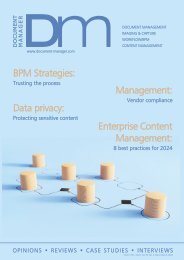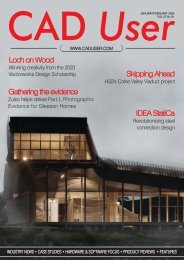You also want an ePaper? Increase the reach of your titles
YUMPU automatically turns print PDFs into web optimized ePapers that Google loves.
COMMENT<br />
Editor:<br />
David Chadwick<br />
(cad.user@btc.co.uk)<br />
News Editor:<br />
Mark Lyward<br />
(mark.lyward@btc.co.uk)<br />
Advertising Sales:<br />
Josh Boulton<br />
(josh.boulton@btc.co.uk)<br />
Production Manager:<br />
Abby Penn<br />
(abby.penn@btc.co.uk)<br />
Design/Layout:<br />
Ian Collis<br />
ian.collis@btc.co.uk<br />
Circulation/Subscriptions:<br />
Christina Willis<br />
(christina.willis@btc.co.uk)<br />
Publisher:<br />
John Jageurs<br />
john.jageurs@btc.co.uk<br />
Published by Barrow &<br />
Thompkins Connexion Ltd.<br />
35 Station Square, Petts Wood,<br />
Kent BR5 1LZ<br />
Tel: +44 (0) 1689 616 000<br />
Fax: +44 (0) 1689 82 66 22<br />
SUBSCRIPTIONS:<br />
UK £35/year, £60/two years,<br />
£80/three years;<br />
Europe:<br />
£48/year, £85 two years,<br />
£127/three years;<br />
R.O.W. £62/year<br />
£115/two years, £168/three years.<br />
Single copies can be bought for £8.50<br />
(includes postage & packaging).<br />
Published 6 times a year.<br />
© <strong>2020</strong> Barrow & Thompkins<br />
Connexion Ltd.<br />
All rights reserved.<br />
No part of the magazine may be<br />
reproduced, without prior consent<br />
in writing, from the publisher<br />
For more magazines from BTC, please visit:<br />
www.btc.co.uk<br />
Articles published reflect the opinions of<br />
the authors and are not necessarily those<br />
of the publisher or his employees. While<br />
every reasonable effort is made to ensure<br />
that the contents of editorial and advertising<br />
are accurate, no responsibility can be<br />
accepted by the publisher for errors, misrepresentations<br />
or any resulting effects<br />
Comment<br />
Keeping your distance<br />
by David Chadwick<br />
Afew days ago I came across an<br />
interesting animated graph on the<br />
Internet, which demonstrated the<br />
relationship between the adoption of<br />
Covid-19 measures in America against<br />
the spread of the virus over a period of a<br />
couple of months. The preventative<br />
measure was the enforcement of mask<br />
wearing in each of the States and its<br />
affect on the spread of the virus. What<br />
was remarkable was that although a<br />
couple of States had high initial rates of<br />
infection, as soon as the wearing of<br />
protective face masks became a policy<br />
within that State, the rates of infection<br />
declined rapidly, and States which had<br />
no face mask wearing policy exhibited<br />
massively expanding rates of infection.<br />
I am well aware of the pros and cons of<br />
wearing face masks to protect yourself<br />
and others from the virus. Some people<br />
doubt their efficacy or that most wearers<br />
are using them wrongly, and that face<br />
masks designed for workers in a dusty<br />
environment with valves on the side are<br />
actually more harmful than not wearing a<br />
mask - a whole range of reasons, right<br />
up to the widely held view in America<br />
that they are an assault on our freedoms.<br />
I use a face mask when I enter a closed<br />
environment where there are other<br />
members of the public. I am generally<br />
one of the few who do in our local<br />
supermarkets, but what is notable is that<br />
even those without masks, on noticing<br />
you dolled up with masks and gloves,<br />
give you the space you need to do your<br />
shopping safely.<br />
This is the crux of the matter. With the<br />
major spread of the virus being<br />
confirmed as a consequence of aerial<br />
transmission, the need to maintain a<br />
greater distance between yourself and<br />
others is important. Forget about the 1 or<br />
2 metre rule as these are arbitrarily<br />
imposed distances meant merely to<br />
remind and encourage people to safely<br />
distance themselves from other people<br />
in populous environments.<br />
With the virus spreading faster in other<br />
parts of the world, and local spikes<br />
causing lockdowns in this country, it is<br />
obvious that the pandemic is far from<br />
over, and that we need to maintain the<br />
discipline that mitigates its spread – and<br />
as we appear to be unable, for the most<br />
part, to stay away from close contact<br />
with other commuters, shoppers,<br />
partygoers and absolute strangers, we<br />
need a bit of technology to help us.<br />
We have two articles in this issue which<br />
provide valuable information to architects<br />
and local authority planning committees<br />
about measures to encourage proper<br />
social distancing. The first, from ArcGIS,<br />
offers a nationwide set of town plans<br />
showing pavement widths on all roads,<br />
enabling the authorities to provide safety<br />
measures in congested areas, while the<br />
second looks at MassMotion from<br />
Oasys, which simulates pedestrian<br />
movement within public environments.<br />
This has now been extended to include<br />
variable levels of social distancing, and<br />
to show where steps need to be taken to<br />
enforce its adoption.<br />
Is this the way we will live from now on -<br />
a split between people who couldn’t care<br />
less about the measures we need to take<br />
to avoid contracting Covid-19 or any<br />
future virus, and those who are fearful of<br />
close personal contact in any shape or<br />
form? The most heartening aspect of it<br />
all I think is that the global scientific<br />
community has been able to analyse,<br />
develop, and begin testing a range of<br />
possible vaccines and other solutions in<br />
an incredibly short timescale.<br />
4 <strong>Jul</strong>y/<strong>Aug</strong>ust <strong>2020</strong>

















